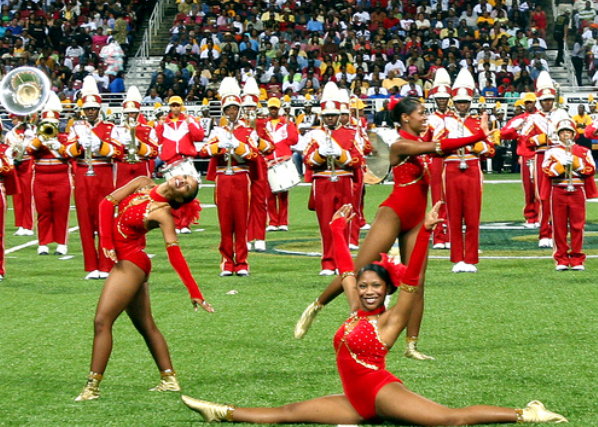Times Staff Report

By most accounts, the first-ever black college football game, played in Salisbury, N.C, in December 1892, had a festive, picnic-like atmosphere not much different from the mood of the games today. But something was missing.
Fans were in the stands. The teams—Biddle (now Johnson C. Smith University) and nearby Livingstone College—played two 45-minute halves of football. There was a break at halftime.
What was missing? The staple of today’s black college football halftime—the drum major opening the show by high-kicking his way to midfield then doing his trademark back bend until his head touches the ground; the marching band struttin’ onto the field with superb instrumentation and intricate formations; the dance squad displaying dazzling style and steps.
The showmanship and pageantry were absent at other college football games of that era, as well. In fact, before the 1920s very few schools had marching bands. But that would change—with black schools in Alabama helping to usher in the marching band era on college campuses.
Military Bands
Sterling Stuckey, University of California, Riverside, Professor Emeritus, and other historians connect black college band showmanship to influences from 13th-century West Africa and the Egun masqueraders of the Yoruba tribe, who would play musical instruments and dance during funeral processions. Other historians point to black drill sergeants, who introduced both melody and foot-stomping syncopation into their cadence counting, permanently altering the standard, Western marching call.
Black marching bands formed as part of the military, with the earliest musicians serving as fifers, drummers, trumpeters, and pipers in Colonial-era militias.
Around the start of the Civil War, brass instruments became a mainstay in military bands. In the Union Army, each all-black regiment had its own instruments and band, which helped recruit through parades and public appearances.
Many would stay on after the war to form the first black units, while others went on to perform in civilian bands. By the late 19th century, marching bands—including the first permanent black minstrel troupes, with one led by blues pioneer W.C. Handy—had become an integral part of American society.
During World War I, many black military units again had bands. Many of these musicians went on to join the faculty of the budding music departments at black colleges and universities, which came about in 1862. The bands were initially formed to help raise money.
It is thought that the earliest historically black college and university (HBCU) band started at the Tuskegee Normal and Industrial Institute (now Tuskegee University) in Tuskegee, Ala., with its Tuskegee Normal School Brass Band. Other early black collegiate bands were established at schools like Alabama State, Florida A&M, and Kentucky State.
As American football evolved, so did the college band. Traditionally, many of the first university marching bands were linked to the Reserve Officers’ Training Corps (ROTC) and supported by athletic departments; they usually performed military drill exercises. The first marching band to deviate from this was the 1905 University of Illinois band, which formed letters, words, and intricate patterns on the field while playing.
FAMU
The showmanship and style that are now hallmarks of the black college band occurred by happenstance at a Florida A&M University (FAMU) practice in 1946.
“Our first dance routine, I don’t know how or why it came about,” says Dr. William Foster, FAMU’s band director emeritus, who is widely acknowledged as the progenitor of black college band showmanship and is the author of “Band Pageantry: A Guide for the Marching Band.”
“It was to the tune of ‘Alexander’s Ragtime Band.’ We were just doing steps and high-knee lifts, and people thought that was the greatest thing on earth. Later, I had a physical education teacher, Beverly Barber, help with the choreography, putting the steps to music.
“I didn’t know what I was doing, but it drew in the audience. The band members hadn’t seen anything like it before, and they thought highly of me so they thought it was all right. Very shortly afterward, other bands started doing it.”
Foster’s break from tradition led to a changing of the guard in marching band style—and forever altered the look, feel, and emotion associated with halftime performances. Those upbeat, high-energy shows replaced the block, militaristic, corps-style band performances.
By the 1960s, HBCU marching bands had developed a distinctive style and tradition. The FAMU band, as well as bands from schools like Grambling, Southern, and Tennessee State, began to garner national attention.
Grambling, guided by legendary director Conrad Hutchinson, got a big break in 1964 when it performed at halftime of the then–American Football League’s championship game in San Diego, Calif. Then, in 1967 the band performed at halftime of the first Super Bowl.
Today, the halftime show can be as big a draw as some of the games, but the band is always mindful that there is still an emphasis on musicianship. After all, that was the original mission of college bands—to attract young people to music, help them become proficient in playing their chosen instruments, and enable them to go on to careers in music.
Alabama’s Other Black College Marching BandsAlabama A&M University Alabama State University Stillman College Talladega College Tuskegee University |
Sources: www.blackvoices.com; http://etaomegakkpsi.webs.com/hbcubandsahistory.htm



